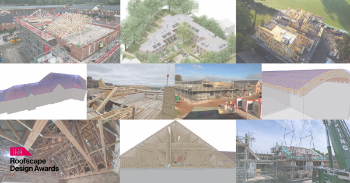Architectural design
Contents |
Introduction
Architecture is both the process and product of planning, designing and construction.
'Architecture' can mean:
- Buildings and other physical structures.
- The style of buildings and other physical structures.
- The method of constructing buildings and other physical structures.
- The practice of the architect.
Architecture as 'the practice of the architect' refers to planning, designing and constructing form, space and ambience. It extends from urban design and masterplanning to building design, the design of individual spaces and even fixtures and fittings. It also includes the pragmatic aspects of realising buildings and structures, including programming, procurement and contract administration.
The term 'architecture' is also commonly used to describe the process of designing any kind of system, and is commonly used in describing information technology.
Architects
The term 'architect' has been used for many centuries, but the architect as a recognised profession is a relatively modern concept dating back to the mid 16th century, from the French architecte and Italian architetto (originating from the Greek arkhitekton, where arkhi means 'chief' and tekton 'builder'). The term and what it represents has evolved through history to its current form in which architects are seen as highly-qualified and educated professionals.
See The History of the architect as a profession for more information.
Although buildings in the UK are commonly designed by people who are not architects, the term ‘architect’ itself is protected. Only qualified individuals that are registered with the ARB can offer their services as architects and companies must obtain the ARB's permission to use the title 'architect' in their name. It is a criminal offence for anyone to offer services as an architect if they are not on the register, Section 20 of the Architects Act states that 'a person shall not practise or carry on business under any name style or title containing the word 'architect' unless he is a person registered under this Act'.
The role of an architect
Detailed descriptions of the tasks performed by an architect for different procurement routes can be found in the free work plans available on the Designing Buildings Wiki home page, however, very broadly, the role performed by an architect might include:
- Assisting the client to prepare a strategic brief.
- Carrying out feasibility studies and options appraisals.
- Advising on the need to appoint other professionals to the consultant team, independent client advisers, specialist designers and specialist contractors.
- Advising on the procurement route.
- Contributing to the preparation of a project brief.
- Preparing the concept design.
- Preparing the detailed design.
- Preparing planning applications.
- Preparing applications for statutory approvals.
- Preparing production information.
- Preparing tender documentation.
- Contributing to the assessment of tenders.
- Reviewing designs prepared by others.
- Acting as contract administrator.
- Inspecting the works.
- Advising on the rectification of defects.
Design
Architecture is a team-working process and rarely a lone activity. There is always a client and there is always an interpreter of that client's needs. The relationship between client and architect is fundamental, and the establishment of a professional and trusting relationship between the two is the bedrock of every successful project.
Creating architecture involves art and beauty, science and engineering, values and beliefs, friendship and team-working. It is one of life's rewarding activities, bringing together a wide range of personalities, skills and expertise. It is an adventure for the client, the architect and their team.
It is important to place that adventure within a sound organisational and contractual context so that procedural complications do not derail the principal activity. A simple, clear, legally-defined understanding of what is involved will benefit the whole process, avoid conflict and help clarify the interrelationships and responsibilities of all the partners involved in commissioning, designing and building a project, large or small.
Architectural services can be procured by a multitude of routes, however, they generally involve certain core activities:
- Receiving and understanding the brief, agreeing how to proceed and gathering data.
- Feasibility and assessment.
- Concept design/outline design.
- Design development.
- Construction data
- Construction procurement.
- Inspection.
- Post-occupancy evaluation
See Concept architectural design for more information.
Design stages
Building projects are generally divided into a series of stages. This helps define payment milestones, information deliverables, decision points, the need for new appointments and so on. The RIBA Plan of work proposes the following stages:
- 0 - Strategic definition.
- 1 - Preparation and brief.
- 2 - Concept design.
- 3 - Developed design.
- 4 - Technical design.
- 5 - Construction.
- 6 - Handover and close out.
- 7 - In use.
Some stages are more creative than others. The concept design stage is generally considered to be the first, and most creative design stage, however this can be a relatively small part of the overall project. It is preceded by a host of non-design activities, such as business planning and justification, brief development and feasibility studies, and it is followed by design development, technical design, procurement and construction, which may again be largely non-creative.
For more information see: Design stages.
Related articles on Designing Buildings Wiki
Featured articles and news
Moisture, fire safety and emerging trends in living walls
How wet is your wall?
Current policy explained and newly published consultation by the UK and Welsh Governments.
British architecture 1919–39. Book review.
Conservation of listed prefabs in Moseley.
Energy industry calls for urgent reform.
Heritage staff wellbeing at work survey.
A five minute introduction.
50th Golden anniversary ECA Edmundson apprentice award
Showcasing the very best electrotechnical and engineering services for half a century.
Welsh government consults on HRBs and reg changes
Seeking feedback on a new regulatory regime and a broad range of issues.
CIOB Client Guide (2nd edition) March 2025
Free download covering statutory dutyholder roles under the Building Safety Act and much more.
AI and automation in 3D modelling and spatial design
Can almost half of design development tasks be automated?
Minister quizzed, as responsibility transfers to MHCLG and BSR publishes new building control guidance.
UK environmental regulations reform 2025
Amid wider new approaches to ensure regulators and regulation support growth.
The maintenance challenge of tenements.
BSRIA Statutory Compliance Inspection Checklist
BG80/2025 now significantly updated to include requirements related to important changes in legislation.
Shortlist for the 2025 Roofscape Design Awards
Talent and innovation showcase announcement from the trussed rafter industry.























Comments